by Francesca Patten
As I wake up at 6:30 AM in Pompei it feels, in many ways, like I never left. Just as was the case last year, when I participated in the pilot season, three alarms sound off simultaneously in our triple room at the Hotel Villa Dei Misteri, signaling the start of the work day. We eat breakfast between 6:50 and 7:10, so having a tight morning routine is of paramount importance. We leave as a group at 7:10 sharp for an arrival at the site at 7:15.
The temperature this morning is in the mid-twenties, but it will likely rise to around 30° Celsius by the early afternoon. As tempting as shorts and tank tops sound, we get dressed according to specific requirements on site for maximum safety — including protection from the sun. Long socks, full-length pants, and steel-toe boots are all required, as well as suggested long sleeve shirts and hats. While various students have chosen varieties of the outfits that work for them, depending, for example, on their heat tolerance and skin sensitivity, the importance of applying sunscreen is universally acknowledged — sometimes three or four times a day.
After getting dressed I pack a bag with everything I’ll need for the morning on site- water, sunglasses, knee pads, my trowel, and a kit with electrolytes, band-aids, and so on. Breakfast is served at the hotel, a selection of pastries and fruit, and then we depart for the site at 7:10. The average work day begins at 7:15 and ends between 4 and 4:30, including an hour-long lunch. We walk the short walk into the park from the hotel, using our ‘Scavi Passes,’ which allow us access to the park before it opens and for free during visiting hours, to enter where the old Office of the Superintendent was located.
While free admission makes our entry to the archaeological park a breeze, the Porta Marina stands menacingly between our entry and the city itself (fig. 1). Scaling the city walls from the West, the ancient gate follows a steep but short incline into the heart of the city. Much like the merchants which made Pompeii so prosperous, however, we conquer the steep slopes and make our way into the Forum (fig. 2) to the Temple of Jupiter where we will collect our tools for a day of work.
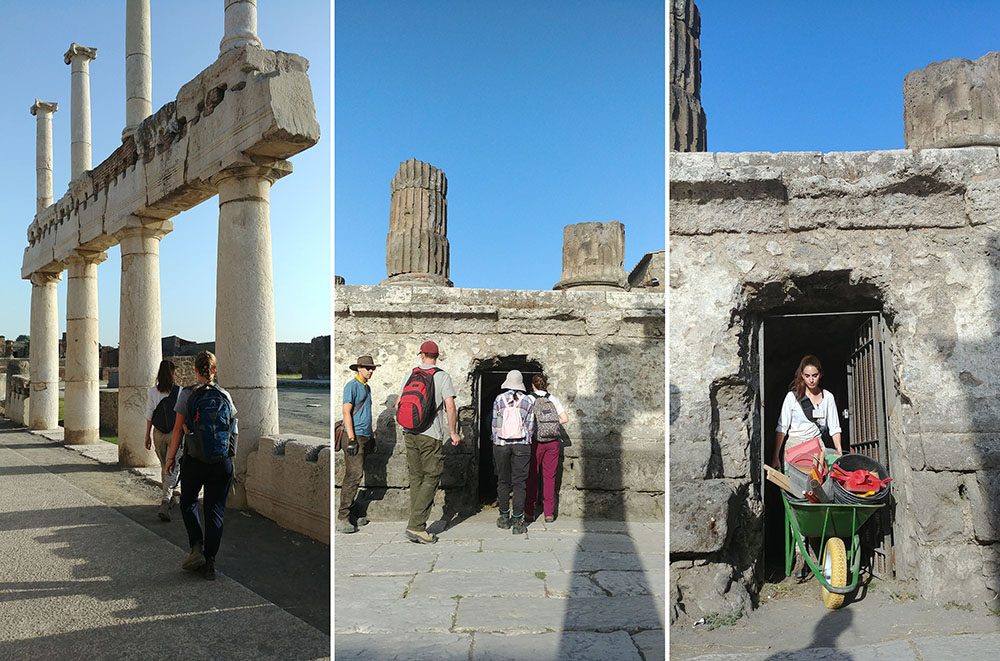
Figures 2, 3 and 4
The Capitolium was under repair at the time of the city’s destruction, but its intact podium is spacious and secure. We enter each morning and distribute the tools amongst all 17 of the students participating in this year’s field school (figs. 3-4). Today, we will need six plastic bins to hold our finds, distributed between our two open areas. As well, we will need pick axes, shovels, brushes, dustpans, buckets, the topography equipment, wheelbarrows, and various other pieces. Once everything is accounted for, we will continue to the Temple of Venus to begin excavating for the day.
While working on site is an essential part of any field school experience, it is only one of three positions that students have to opportunity to be a part of each day. In addition, two students are given instruction in the use of topography equipment with Dr. Daniel Diffendale and Matthew Harder. Using two known elevation points within the sightline of the Total Station, students learn how to calibrate the topography equipment, take resections, and take elevation points anywhere on the site (fig. 5).
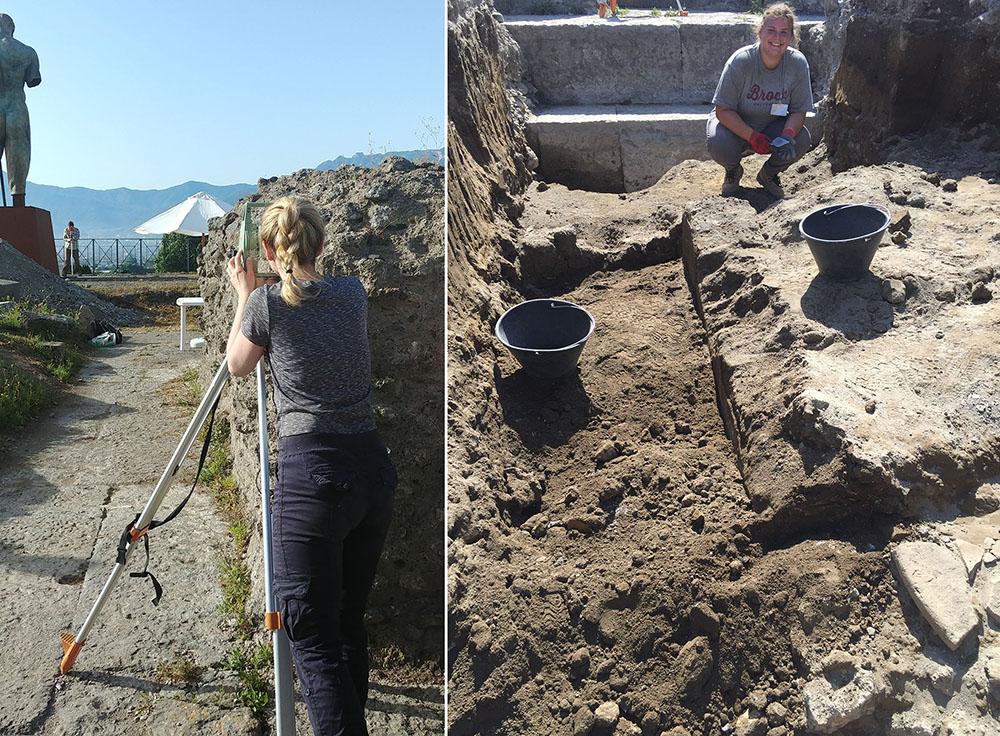
Figures 5 and 6
As well, four students each day work in the pottery lab processing finds from our various stratigraphic units with Massimo Barretta, Mattia D’Acri, and Kaoru Yui. An average day in the pottery lab consists of washing ceramic and brick/tile finds, labeling, sorting, drawing, and classifying all material. While there, students will learn how to identify and classify a variety of finds.
Today on site, we will continue work on our two open trenches, II, located in the western sector of the excavation area, and B, located in the east. Specific activities are varied from day to day, depending on the nature of each stratigraphic context. Today we will to excavate a new unit in Trench II. The unit has visible limits on the North, Easy, and South sides. As such, we will begin by troweling the unit in order to identify its color, composition, and compaction (fig. 6). We do this in order to be able to properly identify when we have reached something new. Upon confirming that the unit is, in this case, large and full of an ancient backfill, we can continue by carefully pickaxing the material. This will mean eventually also having to remove this material from the trench using either shovels and buckets (fig. 7) or trowels and dustpans (fig. 8) (depending on the volume). While material is removed, we will directly identify finds, either in the Trench or using a sifter and wheelbarrow (fig. 9).
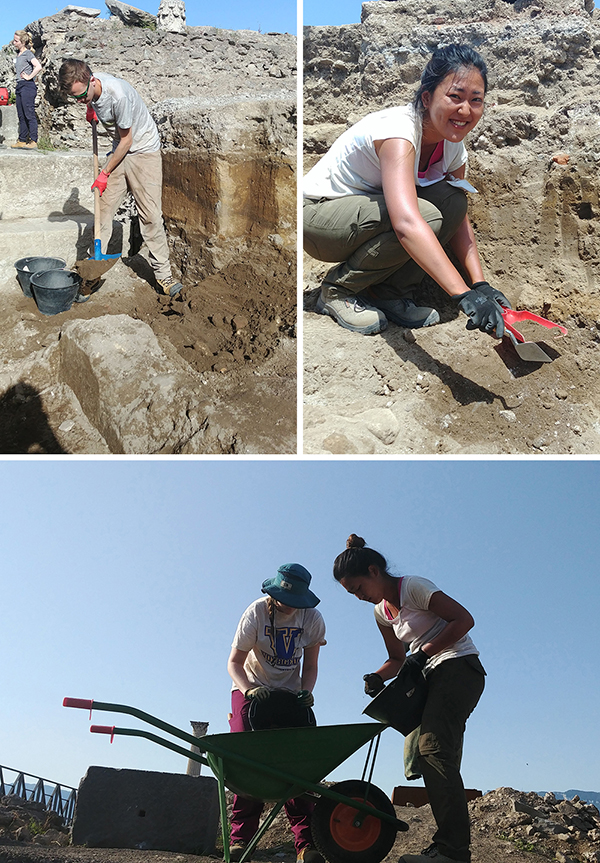
Figures 7, 8 and 9
During the excavation of each unit, we will also fill out S.U. (stratigraphic unit) forms, ensuring that the documentation stays up-to date as the unit is removed (fig. 10). Once the unit is completely excavated, students will use trowels and brushes to clean the limits of the layer below as thoroughly as possible in preparation for further documentation. In addition to completing its paperwork, the students learning from the topographers will assist in taking its limit and elevation points as well as complete photogrammetry of the area. This process is usually repeated multiple times each day, as some units can take several days to fully excavate, whereas others take less than half an hour. At the end of our work day, usually around 4:00 in the afternoon, we collect the tools and ensure the site is clean and organized before returning them inside the Temple of Jupiter’s podium (fig. 11).
Although our field work is done for the day, academic pursuits will continue at the hotel after an hour or so of rest where I, or one of the other staff members, will give lectures on various topics. These lectures seek to further elaborate on the learning experiences which students have on site, sometimes providing historical context for the Roman and pre-Roman phases of the temple which we are excavating, and other times providing practical information on topics such as the Harris Matrix or art conservation processes.
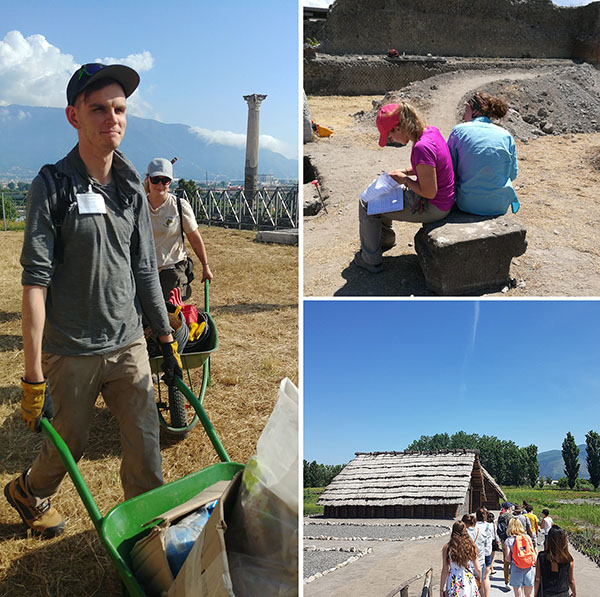 Figures 10, 11, 12
Figures 10, 11, 12
Lectures are not restricted to the hotel, however. On weekdays, students are offered tours of the archaeological site of Pompeii, often by the site’s trench supervisor, Dr. Ivan Varriale, and on weekends to important sites in the region. Last weekend, for example, we had the opportunity to visit the archaeological park of Longola, a protohistoric village which was abandoned in the 6th century BCE but has now been partially reconstructed (fig. 12). Students were guided through the site by Dr. Silvia Bertesago (Pompeii Archaeological Park), who explained the history of the newly opened site and its many archaeological discoveries. Following a day of work, students usually spend their evenings either relaxing by the hotel’s vase shaped pool or walking through the modern town of Pompei. As a town with nearly 2.5 million visitors a year, it is easy to find gelato shops or souvenir vendors lining the streets in the evening. At 8:00, somewhat late by Canadian standards but completely normal in Italy, we will leave for dinner gradually in small groups. The walk to the restaurant is pleasant and short, and students can enjoy oven-baked pizza or pasta with fresh ingredients (fig. 13). Following dinner we will arrive at the hotel around 9:30 or 10:00, when students are happy to relax and get some sleep.
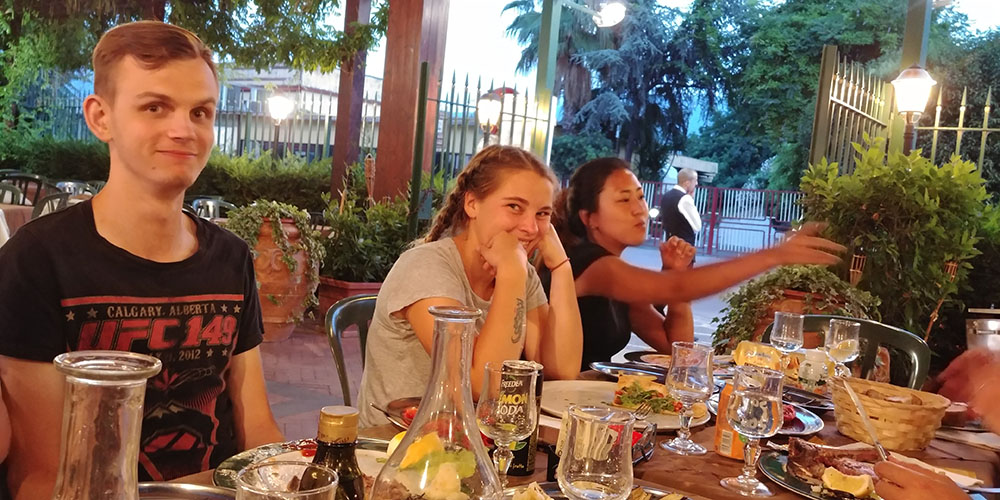
Figure 13
These are the average activities of a day for students on the Venus Pompeiana Project.
 Francesca Patten is a Field Assistant with the VPP. Francesca is a recent graduate of Brock University, where she completed a MA in Classics. Her MRP focused on Samnite building activities at the Temples of Apollo in Pompeii and Cumae. Her other research interests include gender and sexuality in the ancient world and urban development in Roman cities. Previously she completed a BA in Classics (Hons.) with a minor in History at Mount Allison University, where she was awarded a Summer Undergraduate Research Grant to research fortifications in pre- Roman Campania. In Fall 2018, Francesca will begin a Masters in Public Administration at Dalhousie University.
Francesca Patten is a Field Assistant with the VPP. Francesca is a recent graduate of Brock University, where she completed a MA in Classics. Her MRP focused on Samnite building activities at the Temples of Apollo in Pompeii and Cumae. Her other research interests include gender and sexuality in the ancient world and urban development in Roman cities. Previously she completed a BA in Classics (Hons.) with a minor in History at Mount Allison University, where she was awarded a Summer Undergraduate Research Grant to research fortifications in pre- Roman Campania. In Fall 2018, Francesca will begin a Masters in Public Administration at Dalhousie University.
Notifications